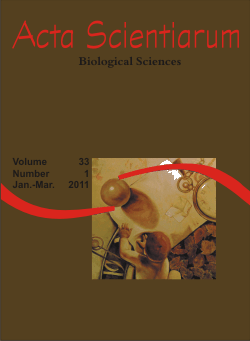<b>The use of HPLC identification and quantification of isoflavones content in samples obtained in pharmacies</b> - doi: 10.4025/actascibiolsci.v33i1.6876
Resumo
Nowadays, there is a great interest in the research and the production of functional foods, such as isoflavones. Which present proven action on the prevention of health problems, such as cancer and cardiovascular diseases. Considering the importance of soybean supplements standardization, this study aimed identifying and quantifying the isoflavones in products sold at different pharmacies. Isoflavones samples were acquired in six different pharmacies specialized in the production of phytotherapic medications. The isoflavones were extracted, quantified and identified in HPLC. None of the samples, from different pharmacies, presented the isoflavones content presented on the label, i.e., 20 mg. In relation to the isoflavones profile, the highest levels found were of daidzein, with up to 66.8 ± 0.09 µg, being the lowest levels the ones of genistein. It is necessary, therefore, the adoption of methods for the standardization and characterization of the raw materials used by different pharmacies. It would assure the isoflavones content, once they are essential for the effects prescribed by the professionals in the medical area.Downloads
DECLARAÇÃO DE ORIGINALIDADE E DIREITOS AUTORAIS
Declaro que o presente artigo é original, não tendo sido submetido à publicação em qualquer outro periódico nacional ou internacional, quer seja em parte ou em sua totalidade.
Os direitos autorais pertencem exclusivamente aos autores. Os direitos de licenciamento utilizados pelo periódico é a licença Creative Commons Attribution 4.0 (CC BY 4.0): são permitidos o compartilhamento (cópia e distribuição do material em qualqer meio ou formato) e adaptação (remix, transformação e criação de material a partir do conteúdo assim licenciado para quaisquer fins, inclusive comerciais.
Recomenda-se a leitura desse link para maiores informações sobre o tema: fornecimento de créditos e referências de forma correta, entre outros detalhes cruciais para uso adequado do material licenciado.












1.png)




3.png)













